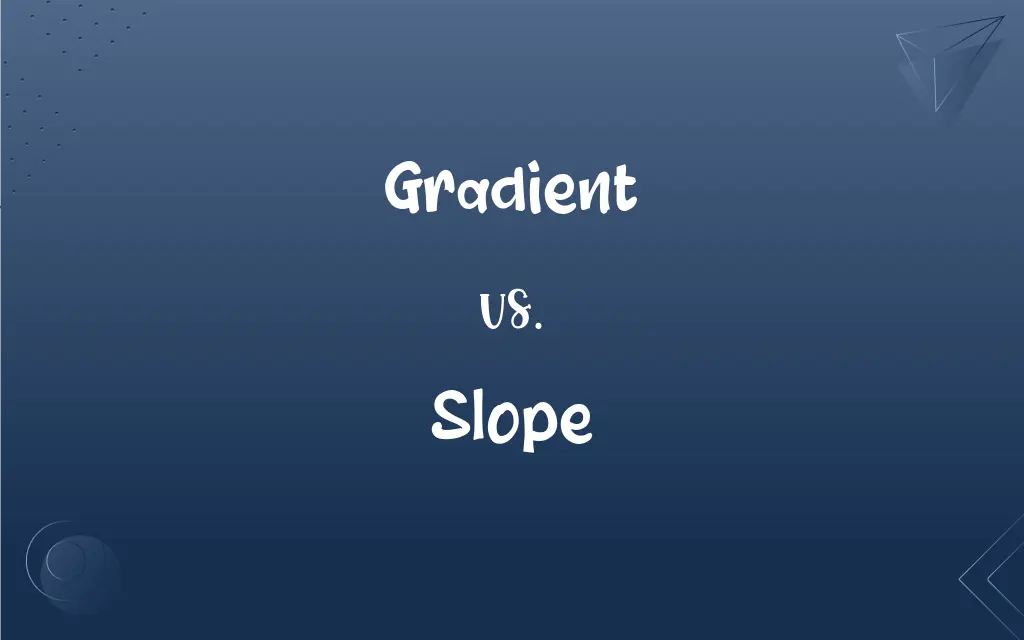Gradient vs. Slope: What's the Difference?
Edited by Harlon Moss || By Janet White || Updated on September 26, 2023
Gradient and Slope both refer to the steepness of a line; Gradient is a vector quantity describing the direction and rate of ascent, while Slope is a scalar quantity representing the inclination between two points.

Key Differences
Gradient and Slope are terms used in mathematics, particularly in geometry and calculus, to describe the rate of change and inclination of a line. Gradient is a vector quantity, emphasizing the directional component and the steepness of the line. It can represent the general slope of a terrain or surface in physical contexts and can be used in multiple dimensions.
Slope, on the other hand, is usually a scalar quantity and is defined as the ratio of the vertical change to the horizontal change between two points on a line. It’s a measure of the line’s steepness, often represented as a ratio or fraction, such as "rise over run." Slope is particularly relevant in algebra, where it’s fundamental in analyzing linear equations.
The term Gradient has applications in physics and other sciences to represent the rate of change of a variable with respect to distance, for example, temperature or pressure gradients. It’s often used to indicate the direction and amount of maximum increase of a scalar field.
Slope is predominantly used in mathematics to analyze and understand the characteristics of lines on a graph, specifically, their inclinations. It’s critical for studying linear relationships between variables and is foundational for understanding linear equations, linear functions, and linear programming.
In essence, both Gradient and Slope serve to quantify the inclination or steepness of a line, with Gradient providing additional directional information, and Slope focusing on the ratio of the vertical to the horizontal change.
ADVERTISEMENT
Comparison Chart
Definition
Vector quantity representing direction and rate of ascent.
Scalar quantity representing the inclination between two points.
Representation
Often represented by a three-dimensional vector.
Typically represented as a ratio or fraction, "rise over run."
Application
Used in various fields like physics for representing rate of change of variable.
Predominantly used in mathematics to understand characteristics of lines.
Dimension
Can be used in multiple dimensions.
Generally used in two dimensions.
Includes
Includes both magnitude and direction.
Involves magnitude only.
ADVERTISEMENT
Gradient and Slope Definitions
Gradient
Gradient is the measure of the steepness or the incline of a surface.
The mountain path had such a sharp gradient that it was challenging to climb.
Slope
Slope is the measure of how much a line inclines vertically over its horizontal change.
The slope of the roof is designed to optimize water runoff.
Gradient
In geography, gradient details the part of a physical landscape's incline.
The gradient of the hill determined the flow direction of the water.
Slope
It is a scalar quantity often represented as "m" in the slope-intercept form of a linear equation.
The slope, m, was found to be 2, representing a steep incline.
Gradient
In physics, a gradient can indicate the rate of change of a physical quantity.
The pressure gradient in the atmosphere affects the wind direction and speed.
Slope
Slope is a crucial concept in understanding and interpreting linear relationships in algebra.
The students learned how the slope is fundamental in interpreting linear relationships between variables.
Gradient
A rate of inclination; a slope.
Slope
To diverge from the vertical or horizontal; incline
A roof that slopes.
Gradient
An ascending or descending part; an incline.
Slope
To move or walk
"Without another word he turned and sloped off down the driveway" (Roald Dahl).
Gradient
(Physics) The rate at which a physical quantity, such as temperature or pressure, changes in response to changes in a given variable, especially distance.
Slope
To cause to slope
Sloped the path down the bank.
Gradient
(Mathematics) A vector having coordinate components that are the partial derivatives of a function with respect to its variables.
Slope
An inclined line, surface, plane, position, or direction.
Gradient
(Biology) A series of progressively increasing or decreasing differences in the growth rate, metabolism, or physiological activity of a cell, organ, or organism.
Slope
A stretch of ground forming a natural or artificial incline
Ski slopes.
Gradient
A slope or incline.
Slope
A deviation from the horizontal.
Gradient
A rate of inclination or declination of a slope.
Slope
The amount or degree of such deviation.
Gradient
The ratio of the rates of change of a dependent variable and an independent variable, the slope of a curve's tangent.
Slope
The rate at which an ordinate of a point of a line on a coordinate plane changes with respect to a change in the abscissa.
Gradient
(science) The rate at which a physical quantity increases or decreases relative to change in a given variable, especially distance.
Slope
The tangent of the angle of inclination of a line, or the slope of the tangent line for a curve or surface.
Gradient
A differential operator that maps each point of a scalar field to a vector pointed in the direction of the greatest rate of change of the scalar. Notation for a scalar field φ: ∇φ
Slope
Offensive Slang Used as a disparaging term for a person of East Asian birth or ancestry.
Gradient
A gradual change in color. A color gradient; gradation.
Slope
An area of ground that tends evenly upward or downward.
I had to climb a small slope to get to the site.
A steep slope
Gradient
Moving by steps; walking.
Slope
The degree to which a surface tends upward or downward.
The road has a very sharp downward slope at that point.
Gradient
Rising or descending by regular degrees of inclination.
The gradient line of a railroad
Slope
(mathematics) The ratio of the vertical and horizontal distances between two points on a line; zero if the line is horizontal, undefined if it is vertical.
The slope of this line is 0.5
Gradient
Adapted for walking, as the feet of certain birds.
Slope
(mathematics) The slope of the line tangent to a curve at a given point.
The slope of a parabola increases linearly with x.
Gradient
Moving by steps; walking; as, gradient automata.
Slope
The angle a roof surface makes with the horizontal, expressed as a ratio of the units of vertical rise to the units of horizontal length (sometimes referred to as run).
The slope of an asphalt shingle roof system should be 4:12 or greater.
Gradient
Rising or descending by regular degrees of inclination; as, the gradient line of a railroad.
Slope
A person of Chinese or other East Asian descent.
Gradient
Adapted for walking, as the feet of certain birds.
Slope
(intransitive) To tend steadily upward or downward.
The road slopes sharply down at that point.
Gradient
The rate of regular or graded ascent or descent in a road; grade.
Slope
(transitive) To form with a slope; to give an oblique or slanting direction to; to incline or slant.
To slope the ground in a garden;
To slope a piece of cloth in cutting a garment
Gradient
A part of a road which slopes upward or downward; a portion of a way not level; a grade.
Slope
To try to move surreptitiously.
I sloped in through the back door, hoping my boss wouldn't see me.
Gradient
The rate of increase or decrease of a variable magnitude, or the curve which represents it; as, a thermometric gradient.
Slope
(military) To hold a rifle at a slope with forearm perpendicular to the body in front holding the butt, the rifle resting on the shoulder.
The order was given to "slope arms".
Gradient
The variation of the concentration of a chemical substance in solution through some linear path; also called concentration gradient; - usually measured in concentration units per unit distance. Concentration gradients are created naturally, e.g. by the diffusion of a substance from a point of high concentration toward regions of lower concentration within a body of liquid; in laboratory techniques they may be made artificially.
Slope
(obsolete) Sloping.
Gradient
A graded change in the magnitude of some physical quantity or dimension
Slope
(obsolete) slopingly
Gradient
The property possessed by a line or surface that departs from the horizontal;
A five-degree gradient
Slope
An oblique direction; a line or direction including from a horizontal line or direction; also, sometimes, an inclination, as of one line or surface to another.
Gradient
Gradient is a vector quantity, denoting the rate and direction of change.
The temperature gradient in the metal bar was noticeable, showing rapid change in one direction.
Slope
Any ground whose surface forms an angle with the plane of the horizon.
Buildings the summit and slope of a hill.
Under the slopes of Pisgah.
Gradient
In mathematics, gradient represents the slope of the tangent of the curve at a given point.
The curve was analyzed to determine the gradient at various points.
Slope
The part of a continent descending toward, and draining to, a particular ocean; as, the Pacific slope.
Slope
Sloping.
A bank not steep, but gently slope.
Slope
In a sloping manner.
Slope
To form with a slope; to give an oblique or slanting direction to; to direct obliquely; to incline; to slant; as, to slope the ground in a garden; to slope a piece of cloth in cutting a garment.
Slope
To take an oblique direction; to be at an angle with the plane of the horizon; to incline; as, the ground slopes.
Slope
To depart; to disappear suddenly.
Slope
An elevated geological formation;
He climbed the steep slope
The house was built on the side of the mountain
Slope
The property possessed by a line or surface that departs from the horizontal;
A five-degree gradient
Slope
Be at an angle;
The terrain sloped down
Slope
In mathematics, slope is the ratio of the vertical rise to the horizontal run between any two points on a line.
The line had a negative slope, indicating a decrease in value.
Slope
Slope represents the degree of steepness of a line on a graph.
By analyzing the graph, we determined the slope between the two points.
FAQs
Is Slope only applicable in mathematics?
While predominantly used in mathematics, slope concept is also applicable in physical construction and geography to represent incline.
What is a Gradient?
Gradient is a vector quantity that represents the direction and rate of ascent or steepness of a line.
How is the Slope of a horizontal line represented?
The slope of a horizontal line is zero, as there is no vertical change.
Does Gradient only involve inclination?
No, gradient involves both inclination and direction, representing them as a vector quantity.
Is Gradient applicable in two-dimensional space?
Gradient is applicable in multiple dimensions, representing rate and direction of change in each.
How is Slope defined?
Slope is defined as the scalar quantity representing the ratio of vertical change to horizontal change between two points on a line.
Can Gradient and Slope be used interchangeably?
While they both measure steepness, they aren’t strictly interchangeable; gradient includes direction and is a vector, while slope is a scalar.
Where is Gradient commonly used?
Gradient is used in physics, mathematics, and geography to represent directional rate of change, steepness, or incline.
Can Gradient be zero?
Yes, gradient can be zero, representing no change in the quantity in any direction.
Can Slope have a negative value?
Yes, a negative slope represents a line that inclines downwards as it moves to the right on a graph.
Is the Slope of a vertical line defined?
No, the slope of a vertical line is undefined as there is no horizontal change.
About Author
Written by
Janet WhiteJanet White has been an esteemed writer and blogger for Difference Wiki. Holding a Master's degree in Science and Medical Journalism from the prestigious Boston University, she has consistently demonstrated her expertise and passion for her field. When she's not immersed in her work, Janet relishes her time exercising, delving into a good book, and cherishing moments with friends and family.
Edited by
Harlon MossHarlon is a seasoned quality moderator and accomplished content writer for Difference Wiki. An alumnus of the prestigious University of California, he earned his degree in Computer Science. Leveraging his academic background, Harlon brings a meticulous and informed perspective to his work, ensuring content accuracy and excellence.































































